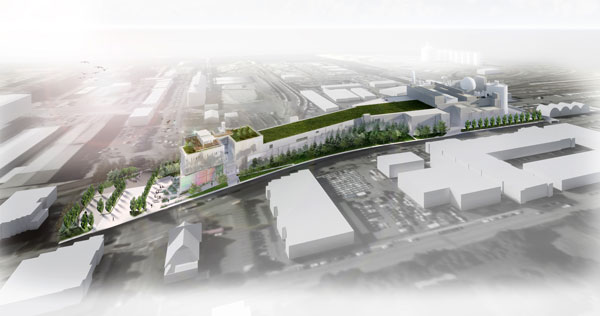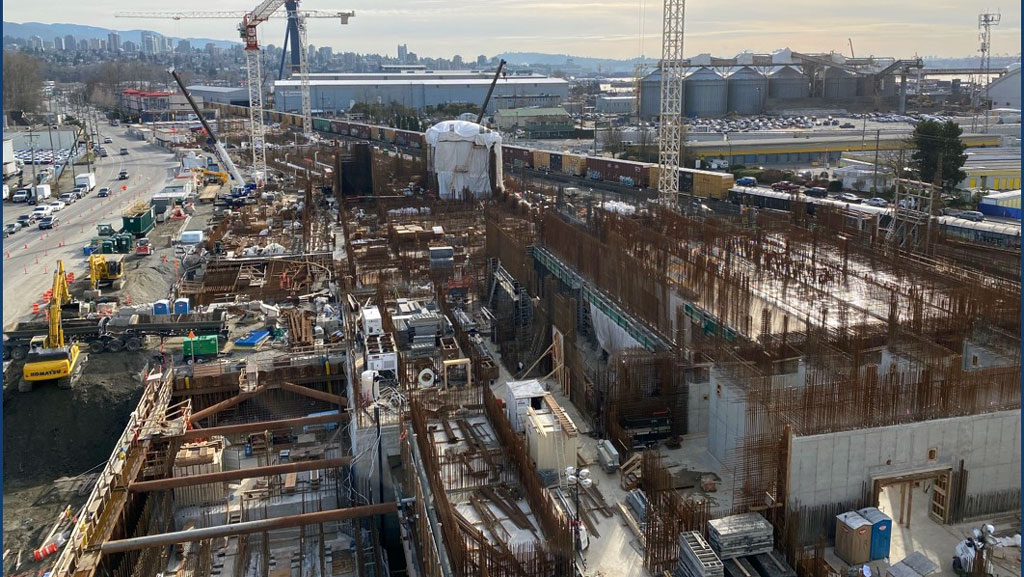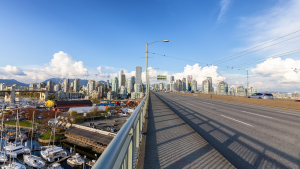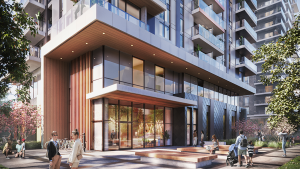Tower cranes hover over the site of the North Shore Wastewater Treatment Plant being built on an eight-acre spread in North Vancouver. Below, large excavators are shovelling dirt into the beds of waiting trucks.
Mobile cranes, telehandlers and other heavy equipment are everywhere on the site and there are stacks of rebar and steel beams. The massive complex is beginning to take shape. Thick walls of concrete are now rising and two massive, cylindrical digesters are being built. When completed, they will be 25 metres tall.
“It’s a big project,” says Metro Vancouver Commissioner and CAO Jerry Dobrovolny. “I think it’s going really well now with a really strong management team looking after the project and working with the contractor.”
The project, however, has been getting a lot of attention lately, not for its benefits, but for the fact it is well over budget and behind its originally scheduled completion date. Cost for the plant, along with a pumping station and two-kilometre-long conveyance pipe, was pegged at $778 million in 2017 and supposed to be completed in 2020. The cost, though, has ballooned to $1.058 billion with completion set for 2024.
The municipality has blamed the delay and price hikes on a number of issues, including difficult ground conditions, seismic requirements, space constraints, geotechnical complications, contractual issues and COVID-19.

“It’s a difficult construction site,” says Dobrovolny. “There’s ground conditions that are there. It’s a very constricted, constrained construction site that we’re working on, and also with COVID as with just about every other large construction project in the country and around the world, we’re struggling. The site is very well managed with respect to COVID but there’s supply chain issues and all kinds of uncertainties.”
The project, along West 1st Street at Pemberton Avenue, consists of the treatment plant, the pipe and pumping station, and a tertiary treatment facility. It is one of the largest construction projects currently underway in the province. The project was designed by Dialog and is being constructed by Acciona. The plant will eventually replace the Lions Gate Wastewater Treatment Plant which will be decommissioned.
Construction on the conveyance project is expected to reach substantial completion this summer and includes the build of a 2.1-metre diameter outflow pipe and one-metre-diameter forcemain. The pumping station and pipes are needed to move wastewater from Lions Gate Bridge to the new plant and move treated wastewater from the new plant to the outfall.
The tertiary treatment facility was added as a result of stakeholder input and upped the pricetag of the project by about $29 million. The secondary treatment capability adds bacteriological breakdown of waste and will remove more substances from the treated wastewater that is flushed into Burrard Inlet.
At the treatment plant itself, roughly 250 trades are onsite. Large volumes of concrete are being poured and work continues on the two large digesters, each 22 metres in diameter. The digesters each have 10 metres of cylindrical concrete cone at the bottom which poses a challenge when forming the concrete.

“The scale is pretty immense for a pretty small site,” notes Dobrovolny. “We’ve got 80,000 cubic metres of concrete that are going to be placed, 30,000 is done already. There’s 24,000 tonnes of rebar, there’s 40 kilometres of piping and 420 kilometres of cabling. It is a unique design because it’s just a small site.”
The project is now in the “concrete phase,” says Dobrovolny, which is going well with roughly half of the pours completed.
“The foundations are about 80 per cent done and the superstructure is underway. Over a period of time it’s a massive concrete pour.”
The facility is important to Metro Vancouver because it reflects a commitment to protecting the environment and habitat, says Dobrovolny. The facility itself is being built to achieve the LEED Gold standard. It will meet the latest seismic standards, be resilient to future sea level rises and generate 75 per cent fewer greenhouse gas emissions. The onsite recycling rate during construction is running at about 95 per cent.
The plant will also feature an odour-abatement system with an enclosed design that will control fumes from the facility, as well as water conservation through harvesting and reusing rainwater outside of the plant.
Burrard Inlet is an important habitat for salmon and whales so Metro Vancouver wanted to get ahead of the game and better regulate the treatment of wastewater as part of the project, states Dobrovolny.
“It was cheaper for us to do it now as part of this construction and we did anticipate it coming in the future,” he says.
For the contractor, the big challenge is co-ordinating all the work being done on such a small site.
The North Shore project also has a number of levels and a stacked design, so it’s unique and a more complex build for the contractor.
“It’s very unusual to see a multi-storey sewage treatment plant,” says Dobrovolny. “The rest of ours are vast.”
The contractor and trades are using Building Information Modeling, or BIM, to keep everybody in the loop.
“With 250 tradespeople onsite you have to keep everybody co-ordinated and not bumping into each other,” says Dobrovolny.











Recent Comments
comments for this post are closed